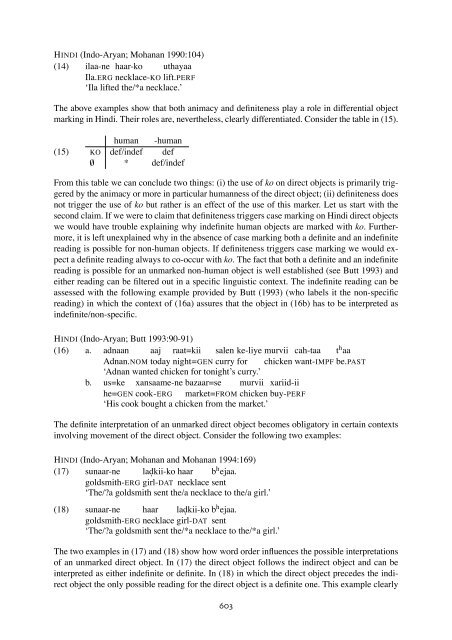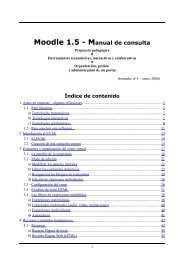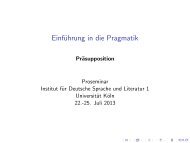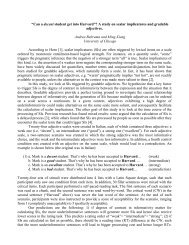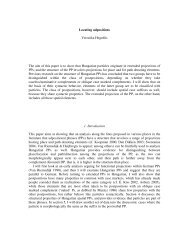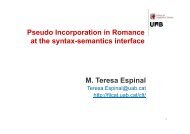Semantic aspects of differential object marking - corpora@parles.upf ...
Semantic aspects of differential object marking - corpora@parles.upf ...
Semantic aspects of differential object marking - corpora@parles.upf ...
You also want an ePaper? Increase the reach of your titles
YUMPU automatically turns print PDFs into web optimized ePapers that Google loves.
6 Peter de Swart and Helen de Hoop<br />
HINDI (Indo-Aryan; Mohanan 1990:104)<br />
(14) ilaa-ne haar-ko uthayaa<br />
Ila.ERG necklace-KO lift.PERF<br />
‘Ila lifted the/*a necklace.’<br />
The above examples show that both animacy and definiteness play a role in <strong>differential</strong> <strong>object</strong><br />
<strong>marking</strong> in Hindi. Their roles are, nevertheless, clearly differentiated. Consider the table in (15).<br />
(15)<br />
human -human<br />
KO def/indef def<br />
/0 * def/indef<br />
From this table we can conclude two things: (i) the use <strong>of</strong> ko on direct <strong>object</strong>s is primarily triggered<br />
by the animacy or more in particular humanness <strong>of</strong> the direct <strong>object</strong>; (ii) definiteness does<br />
not trigger the use <strong>of</strong> ko but rather is an effect <strong>of</strong> the use <strong>of</strong> this marker. Let us start with the<br />
second claim. If we were to claim that definiteness triggers case <strong>marking</strong> on Hindi direct <strong>object</strong>s<br />
we would have trouble explaining why indefinite human <strong>object</strong>s are marked with ko. Furthermore,<br />
it is left unexplained why in the absence <strong>of</strong> case <strong>marking</strong> both a definite and an indefinite<br />
reading is possible for non-human <strong>object</strong>s. If definiteness triggers case <strong>marking</strong> we would expect<br />
a definite reading always to co-occur with ko. The fact that both a definite and an indefinite<br />
reading is possible for an unmarked non-human <strong>object</strong> is well established (see Butt 1993) and<br />
either reading can be filtered out in a specific linguistic context. The indefinite reading can be<br />
assessed with the following example provided by Butt (1993) (who labels it the non-specific<br />
reading) in which the context <strong>of</strong> (16a) assures that the <strong>object</strong> in (16b) has to be interpreted as<br />
indefinite/non-specific.<br />
HINDI (Indo-Aryan; Butt 1993:90-91)<br />
(16) a. adnaan aaj raat=kii salen ke-liye murvii cah-taa t<br />
Adnan.NOM today night=GEN curry for chicken want-IMPF<br />
haa ‘Adnan wanted chicken for tonight’s curry.’<br />
be.PAST<br />
b. us=ke xansaame-ne bazaar=se murvii xariid-ii<br />
he=GEN cook-ERG market=FROM chicken buy-PERF<br />
‘His cook bought a chicken from the market.’<br />
The definite interpretation <strong>of</strong> an unmarked direct <strong>object</strong> becomes obligatory in certain contexts<br />
involving movement <strong>of</strong> the direct <strong>object</strong>. Consider the following two examples:<br />
HINDI (Indo-Aryan; Mohanan and Mohanan 1994:169)<br />
(17) sunaar-ne lad.kii-ko haar b<br />
goldsmith-ERG girl-DAT necklace<br />
hejaa. sent<br />
‘The/?a goldsmith sent the/a necklace to the/a girl.’<br />
(18) sunaar-ne haar lad.kii-ko b<br />
goldsmith-ERG necklace girl-DAT<br />
hejaa. sent<br />
‘The/?a goldsmith sent the/*a necklace to the/*a girl.’<br />
The two examples in (17) and (18) show how word order influences the possible interpretations<br />
<strong>of</strong> an unmarked direct <strong>object</strong>. In (17) the direct <strong>object</strong> follows the indirect <strong>object</strong> and can be<br />
interpreted as either indefinite or definite. In (18) in which the direct <strong>object</strong> precedes the indirect<br />
<strong>object</strong> the only possible reading for the direct <strong>object</strong> is a definite one. This example clearly<br />
603<br />
6


